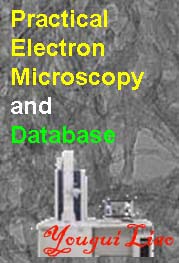
Chapter/Index: Introduction | A | B | C | D | E | F | G | H | I | J | K | L | M | N | O | P | Q | R | S | T | U | V | W | X | Y | Z | Appendix
| In EELS systems, the collection angle, β, of electrons leaving the specimen is determined by the spectrometer entrance aperture and camera length. In the case that the illumination is highly defocused (over tens of microns), the specimen is homogeneous over tens of microns, and the size of the illuminated area on the viewing screen is much larger than the spectrometer entrance aperture, the electrons that miss the spectrometer entrance aperture due to chromatic aberration will be replaced by a similar number of electrons that enter the aperture in error also due to chromatic aberration. Operating under these conditions is sometimes useful on contamination-prone specimens, or when one needs to spread the illumination over a large are to minimize radiation damage, while maintaining some spatial resolution or a high collection angle. Table 2400a shows that by using an entrance aperture (or collection angle) that is small enough, the effect of aberrations on energy resolution of the EEL spectrometers will be minimized, although a portion of the signal is lost. Based on Table 2400b, the collection angle for EELS measurements is normally in the range of 0 – 21.5 mrad. There is a trade-off between the EELS signal strength and energy resolution in the selection of collector aperture (also called entrance aperture) sizes, because of the following reasons: Aperture sizes in the range of 0.5 to 5 m are typically provided by the manufacturers and applied in various analyses.
Inelastic scattering leads to a Lorentzian angular distribution with a characteristic angle approximately given by the relation for high energy electrons: [1] To optimize the sensitivity for a given edge, we need: On the other hand, another consideration is that the magnitude of the entrance aperture is chosen as a compromise between maximizing both the signal-to-noise (SNR) and the signal-to-background ratio (SBR). In practice, a good compromise is to employ a collection angle of ~2-3ΘE. [1]
Table 2400a. Comparison between effects of large and small collection angles in EELS measurements.
Table 2400b. Examples of optimized collection angles based on Equation 2400 for E0 = 30 - 400 keV.
Figure 2400b shows the collection efficiency of EELS as a function of the collection angle for a primary electron beam of 200 keV. For instance, with the optimized collection semi-angle of 4.7 mrad for Cu L3 (931 eV), only ~30 % of the total available signal is collected by the EELS detector. However, as discussed above, in practice, it is not desirable to collect all of the scattered electrons.
[1] C. C.Ahn, Transmission Electron Energy Loss Spectrometry in Materials Science and the EELS Atlas, 2004.
|
||||||||||||||||||||||||||||||||||||||||||||||||||||||||||||||||||||||||||||||||||||||||||||||||||||||||||||||||||||||||||||||